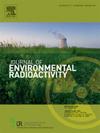Radio-sulfur (35S) as short-term water residence time tracer – Step-by-step instruction for sample preparation and LSC setup
IF 1.9
3区 环境科学与生态学
Q3 ENVIRONMENTAL SCIENCES
引用次数: 0
Abstract
Due to its short half-life (87 days), naturally occurring radio-sulfur (35S) is applicable as aqueous environmental tracer for investigating groundwater residence times shorter than one year. Being a pure β-decaying radionuclide, 35S is detected straightforwardly by means of liquid scintillation counting (LSC). The rather low 35S activities in natural waters require (i) a careful sample preparation aiming at extracting 35SO42− from large-volume water samples (ca. 20 L) resulting in samples ready for LSC measurement and (ii) an optimal device-specific setup of the LSC to maximize the 35S signal-to-noise-ratio. A few publications that discuss approaches for sample preparation and device-specific LSC setup optimization are available. This paper presents a summarizing step-by-step instruction for both optimized sample preparation and LSC setup. For practical reasons, two different sample preparation approaches are presented, one for samples with low total sulphate inventories (up to 350 mg) and one for samples with elevated total sulphate inventories (350–1500 mg). LSC setup optimization aiming at the measurement of the two resulting types of samples is described for three LSC devices, namely Quantulus GCT, TriCarb 3170 TR/SL, and Quantulus LB 1220.
放射性硫(35S)作为短期水停留时间示踪剂-样品制备和LSC设置的逐步指导
由于其半衰期短(87天),自然产生的放射性硫(35S)可作为水环境示踪剂,用于调查地下水停留时间少于一年的情况。35S是一种纯β衰变放射性核素,可以通过液体闪烁计数(LSC)直接检测到。天然水域中35S活性相当低,需要(i)仔细的样品制备,旨在从大容量水样(约20 L)中提取35SO42 -,从而使样品准备好用于LSC测量;(ii) LSC的最佳设备特定设置,以最大限度地提高35S信噪比。一些讨论样品制备方法和特定器件LSC设置优化的出版物是可用的。本文介绍了优化样品制备和LSC设置的总结一步一步的指导。出于实际原因,提出了两种不同的样品制备方法,一种用于低总硫酸盐库存(高达350毫克)的样品,另一种用于总硫酸盐库存(350 - 1500毫克)升高的样品。本文以quantum GCT、TriCarb 3170 TR/SL和quantum LB 1220三种LSC器件为对象,针对两种样品的测量结果进行了LSC设置优化。
本文章由计算机程序翻译,如有差异,请以英文原文为准。
求助全文
约1分钟内获得全文
求助全文
来源期刊

Journal of environmental radioactivity
环境科学-环境科学
CiteScore
4.70
自引率
13.00%
发文量
209
审稿时长
73 days
期刊介绍:
The Journal of Environmental Radioactivity provides a coherent international forum for publication of original research or review papers on any aspect of the occurrence of radioactivity in natural systems.
Relevant subject areas range from applications of environmental radionuclides as mechanistic or timescale tracers of natural processes to assessments of the radioecological or radiological effects of ambient radioactivity. Papers deal with naturally occurring nuclides or with those created and released by man through nuclear weapons manufacture and testing, energy production, fuel-cycle technology, etc. Reports on radioactivity in the oceans, sediments, rivers, lakes, groundwaters, soils, atmosphere and all divisions of the biosphere are welcomed, but these should not simply be of a monitoring nature unless the data are particularly innovative.
 求助内容:
求助内容: 应助结果提醒方式:
应助结果提醒方式:


